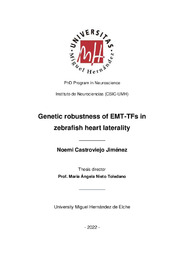Resumen :
Most animals exhibit an external bilateral symmetry while there is an interior left-right (L/R) asymmetry regarding the position of the visceral organs, which is fundamental for their proper function. During development, these asymmetries are set up through the establishment of an intricated L/R cascade along the lateral plate mesoderm (LPM). In vertebrates, there are two parallel and mutually repressed pathways. The TGF-β family member Nodal exerts a dual function on the left-hand side. With its downstream target, Pitx2a, a paired-like homeodomain transcription factor (TF), it establishes left identity, and through the activation of several microRNAs, it attenuates the inducers of the epithelial-to-mesenchymal transition (EMT) on the left-hand side. This attenuation allows the predominance of the BMP pathway on the right LPM, where transient higher levels of its targets, EMT inducers such as Prrx1 and Snail1, lead to a differential L/R EMT that drives the leftward displacement of the posterior pole of the heart in vertebrates. Subsequent looping leads to the final position of the heart and laterality features optimal for its function.
In zebrafish, prrx1a acute loss-of-function (LOF) leads to a mesocardia phenotype due to the failure in the asymmetric contribution of cells that drives heart laterality. However, it has been shown that different allelic mutants for this EMT-TF present normal hearts. To better understand the role of Prrx1 and the overall process of heart laterality, we have investigated (i) the specificity of the described mesocardia phenotype, and (ii) the mechanism that can lead to the appearance of normal hearts in the prrx mutant background. With respect to specificity, using both, several sets of CRISPR/Cas9 RNA guides and a novel CRISPR/Cas13d-mediated strategy that targets the mRNA rather than editing the genome, we have confirmed the mesocardia phenotype. Regarding the mechanism, we have uncovered that both the cardiac TF tbx5a and additional EMT-TFs, namely prrx1b, twist1a and snail1b, also show a L/R asymmetric expression in the aLPM and lead to mesocardia after their CRISPR-Cas9-mediated acute loss in generation 0 (G0) embryos. Furthermore, LOF in G0 embryos for combinations of these TFs, reveal their cooperation in the process of heart laterality in the zebrafish. This cooperative behaviour of different EMT-TFs can explain the compensation of the phenotype in the prrx1a mutant background and provides robustness to the system, securing the proper position and, therefore, function of the heart.
|
 La licencia se describe como: Atribución-NonComercial-NoDerivada 4.0 Internacional.
La licencia se describe como: Atribución-NonComercial-NoDerivada 4.0 Internacional.
.png)
